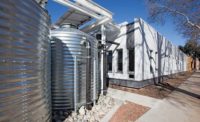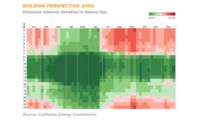Green Buildings
Database Aims to Remove Code Barriers to Sustainability

Pilot Retrofit The goal is to have more than 300 case studies in the database’s hopper by 2019. An example is the Supply Laundry Building retrofit (above) under Seattle’s outcome-based energy-code program. Photo courtesy Vulcan Real Estate
Watershed Management Group, a Tucson-based nonprofit, initiated a research project with the ultimate goal of convincing Arizona building officials to accept non-code-compliant composting toilets—critical to potable water conservation in buildings—as an alternative to an onsite wastewater system. Fallmouth, Mass., has a pilot project to evaluate the efficacy, installation cost and public acceptance of both composting and urine-diverting toilets. And Seattle has the first outcome-based energy-code pilot program in the U.S.
Details about the three code-reform initiatives—and dozens of other green regulatory efforts—are part of the Code Innovations Database. Code officials, policymakers and building teams looking for pioneering sustainable-building policies, pilot initiatives and project case studies can search the database free of charge.
The goal is to break down code barriers to sustainable-building production by disseminating information gathered from high-performance-building pioneers.
“Green building innovators are driving forward new designs, materials and technologies,” says Chris van Daalen, principal investigator for the fledgling database, launched in 2014 by the nonprofit Northwest EcoBuilding Guild. “Too often they face regulatory disconnects that prevent their best ideas from being adopted more broadly,” he adds. “This database is for others who may want to follow in [the innovators’] footsteps.”
This year, the group launched an expansion of its database, thanks to $100,000 in 2016 funding from multiple donors, including a crowd-funding campaign and the Edwards Mother Earth Foundation.
The goal is to have more than 300 case studies by the end of 2018—nearly a tenfold increase since the end of last year. Multiple examples of the same type of innovation will allow users to compare and contrast, says van Daalen. Also, the database will include approved codes, policies and incentives, not simply case studies.
The database is a “great resource” because it allows green-building designers to work as a community to demonstrate to code officials that new technologies are tried and safe, says Dan Welch, owner of Bundle Design Studio. He says the database also serves as an idea-sharing bulletin board for the green-building community.
“The database serves a great purpose” in places that still have energy-code barriers to innovation.
—Kinley Deller
Waste Reduction Specialist, King County Green Tools Program
A longer-term goal is for a global repository of information. When it comes to sustainability, “Europe is 10 years ahead of the U.S.,” says van Daalen. For example, outcome-based energy codes, which require post-occupancy energy-use data to achieve compliance, already exist in Europe but not in the U.S., he says.
The historic retrofit of the 110-year-old Supply Laundry Building—a Code Innovations Database case study—may help change that. The retrofit is the first project permitted through Seattle’s Outcome-based Energy Code Pilot Project.
“The database serves a great purpose” in places that still have energy-code barriers to innovation, by providing building teams with a tool to have dialogues about designs among themselves or with code officials, says Kinley Deller, waste reduction specialist in the Green Tools Program of King County, Wash. It is also useful for code officials to learn about innovative green-building policies and pilot projects elsewhere, so they do not have to reinvent the wheel, he adds.
Dan Wildenhaus, building science manager for CLEAResult, an energy efficiency consultancy, adds, “The Code Innovations Database is a way to make sure the speed of innovation is not held back by the code-change process, which is relatively slow-moving.”





